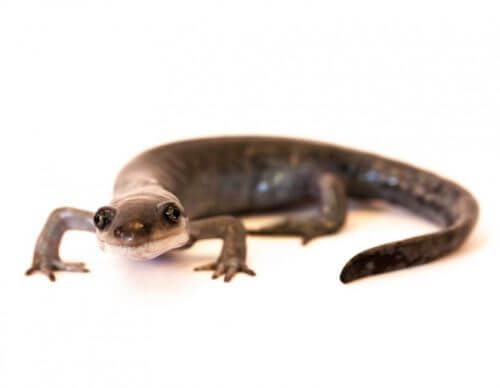Research has shown that a unique lineage of all-female salamanders balances male genes belonging to three other salamander species. The study highlights the strange ways in which animals reproduce to preserve the biological species

A species of hybrid salamanders, all of which are female, have found a genetic formula for success - to mate with many males and use equal parts of each partner's genetic load in their offspring. The research reveals ways in which some animal species - all-female populations of fish, lizards and others - can use their genes to increase their chances of success. Photo: Robert Denton, Iowa State University
The promiscuous salamander found a simple genetic path to success - to mate with many males and use equal parts of their genetic material in its offspring / A study led by biologists at Iowa State University analyzed the genome of Ambystoma, a six-million-year-old line of salamanders that only gives birth to females. The team discovered that most of their genetic profile consisted of contributions from males from three separate species of salamanders: Ambystoma laterale, Ambystoma texanum, n- Ambystoma tigrinum.
The researchers believe that the balanced genome of female salamanders points to a strange way in which some animals - mainly female lineages of fish and lizards - can use their genomes to increase their chances of success.
"Our hypothesis was that the successful individuals have a balanced genetic expression" says Maureen Neiman, professor of biology at the University of Iowa and the principal investigator of the article published in the journal Genome Biology and Evolution. "The balance may be a prerequisite for the emergence and continued success of this hybrid dynasty."
Sexual reproduction dominates the animal world. The unisexual salamander Ambystoma also has sex but for a slightly different purpose. When the female mates, she takes in the male's genes and keeps only some of them, and destroys others. This phenomenon is known as kleptogenesis or theft of genetic material from a male donor for reproductive purposes (or in human terms sperm theft).
The Iowa researchers wondered how the female salamander chooses which genes to keep and use when she mates with a male of another salamander species. The team members analyzed about 3,000 genes of the unisexual females that have three sets of genes (triploid). Of these, they found that 72% of the genes provided by three partners were equally expressed. In other words, the female salamanders choose to use roughly the same number of genes from each salamander species.
"In most cases there is a balance. The three genomes are equally expressed in the hybrid females," says Kyle McClory, a doctoral student in Neiman's lab. "What we wanted to test is how the selection process is done and how genes from three species of salamanders can combine to create a successful hybrid creature."
Instead of a female salamander individually choosing the genes from among the thousands of genes available to her - a complex process - the salamander seems to have found a balanced ratio of genes from the males from the other three species that work for her and stayed with this 'choice'. "It was difficult to preserve this species without the balance," says McElroy. "And this balance may be the key to the success of the hybrid salamander."

9 תגובות
Miracles
You made your point clear which is that you are a gay lover.
Maybe enough already with this homosexual propaganda?
Reminds me of a book I read not long ago
From the book The Tao of Piglet by author Benjamin Hoff. (sequel to Winnie the Pooh)
"Amazons E-ah" call themselves feminists, but this word does not suit them at all.
They don't like femininity (they don't like women's qualities). Instead they are male lusts.”
A little sense of humor - so what?
If it was written "promiscuous salamander" no one would beep, but to write with a "promiscuous" female salamander - you'll soon have Merav Michaeli.
Shlomit
In the original article, a word is written that is difficult to translate into Hebrew, but I think you are right that "promiscuous" sounds too negative.
By the way - maybe the problem is with us: you can certainly say that a rooster is promiscuous, but our education gives a more negative connotation when it comes to a female.
Please go to the original news and see that the researchers wrote this name. I translated.
You really should be ashamed of this misogynistic article. Why promiscuous? Is this the title that came to your mind in response? Because she makes sure that her offspring have the best selection of genes? Only males are allowed to spread the genome? Females are also allowed to choose how to behave. For example, on the Weizmann Institute's website (Davidson Online) they chose to call her the gene thief, without implying that females can only be promiscuous. I suggest changing and improvising the title. DavidsonOnLine@
If all the offspring are female, where do the males come from?
A literal translation of the name in English (specified for the first time)
First, the salamander is not a "sperm thief" - the donation of the sperm was given cheerfully and happily, and she did not even file a single paternity claim and a demand for the payment of alimony for any of the males. Second, "promiscuous salamander" is the name of its biological species, or the author's opinion about its sexual habits?